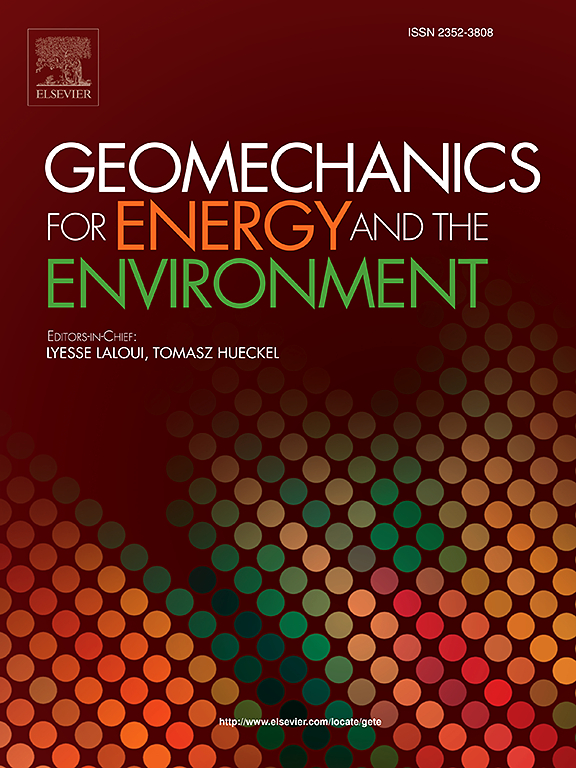热活性挡土墙后非饱和土压力的温度和位移依赖模型
IF 3.7
2区 工程技术
Q3 ENERGY & FUELS
引用次数: 0
摘要
热工挡土墙背后的土压力不仅会受到非饱和回填体温度相关响应的影响,还会受到耦合热泵制冷和加热过程中墙体热膨胀或收缩的影响。这种侧向变形使非饱和充填体处于被动或主动的中间状态。在本研究中,提出了一个分析框架来计算嵌入式热活性挡土墙后非饱和土的温度和位移相关土压力。通过将该模型的结果与文献中报道的现场规模试验结果进行比较,证明了该模型的应用。在25 °C, 35 °C和45 °C的条件下,对6米嵌入式热活性墙进行了一组参数研究,回填了三种假设的土壤(粘土,淤泥和沙子)。此外,在冷却和加热循环过程中,产生了各种热致膨胀和收缩的非饱和土压力剖面。结果表明:温度升高使被动土压力减小,静息状态和活动状态下拉裂缝深度减小;此外,在冷却循环期间,侧壁膨胀有助于消除张力区。然而,热泵的加热循环可能是至关重要的,因为它会导致墙体的侧向收缩,从而形成一个拉伸裂纹区,这可能会对系统的功效产生负面影响。所提出的框架是法医研究的有用工具,以及通过连接岩土和结构方面来评估工作应力条件下嵌入式热活性挡土墙的可用性。本文章由计算机程序翻译,如有差异,请以英文原文为准。
Temperature- and Displacement-Dependent Model for unsaturated Earth pressures behind thermo-active retaining walls
Earth pressures behind a thermo-active retaining wall can be influenced not only by the temperature-dependent response of the unsaturated backfill but also by the thermal expansion or contraction of the wall during the cooling and heating operations of a coupled heat pump. Such lateral deformations cause the unsaturated backfill to be placed in an intermediate passive or active state. In this study, an analytical framework is presented to compute the temperature- and displacement-dependent earth pressures of unsaturated soils behind embedded thermo-active retaining walls. The application of the proposed model is demonstrated by comparing its results with those from field-scale tests reported in the literature. A set of parametric studies is performed on a 6-m embedded thermo-active wall backfilled with three hypothetical soils (clay, silt, and sand) at 25 °C, 35 °C, and 45 °C. Further, unsaturated earth pressure profiles are generated for various thermally induced expansions and contractions during cooling and heating cycles. The results show that elevated temperatures decrease passive earth pressure and reduce the depth of tension cracks in at-rest and active states. Additionally, lateral wall expansion during the cooling cycle helps eliminate the tension zone. However, the heating cycle of the heat pump can be critical, as it leads to lateral contraction of the wall, thereby developing a tension-cracked zone, which can negatively affect the system’s efficacy. The presented framework is a useful tool for forensic studies as well as assessing the serviceability of embedded thermo-active retaining walls under working stress conditions by linking geotechnical and structural aspects.
求助全文
通过发布文献求助,成功后即可免费获取论文全文。
去求助
来源期刊

Geomechanics for Energy and the Environment
Earth and Planetary Sciences-Geotechnical Engineering and Engineering Geology
CiteScore
5.90
自引率
11.80%
发文量
87
期刊介绍:
The aim of the Journal is to publish research results of the highest quality and of lasting importance on the subject of geomechanics, with the focus on applications to geological energy production and storage, and the interaction of soils and rocks with the natural and engineered environment. Special attention is given to concepts and developments of new energy geotechnologies that comprise intrinsic mechanisms protecting the environment against a potential engineering induced damage, hence warranting sustainable usage of energy resources.
The scope of the journal is broad, including fundamental concepts in geomechanics and mechanics of porous media, the experiments and analysis of novel phenomena and applications. Of special interest are issues resulting from coupling of particular physics, chemistry and biology of external forcings, as well as of pore fluid/gas and minerals to the solid mechanics of the medium skeleton and pore fluid mechanics. The multi-scale and inter-scale interactions between the phenomena and the behavior representations are also of particular interest. Contributions to general theoretical approach to these issues, but of potential reference to geomechanics in its context of energy and the environment are also most welcome.
 求助内容:
求助内容: 应助结果提醒方式:
应助结果提醒方式:


